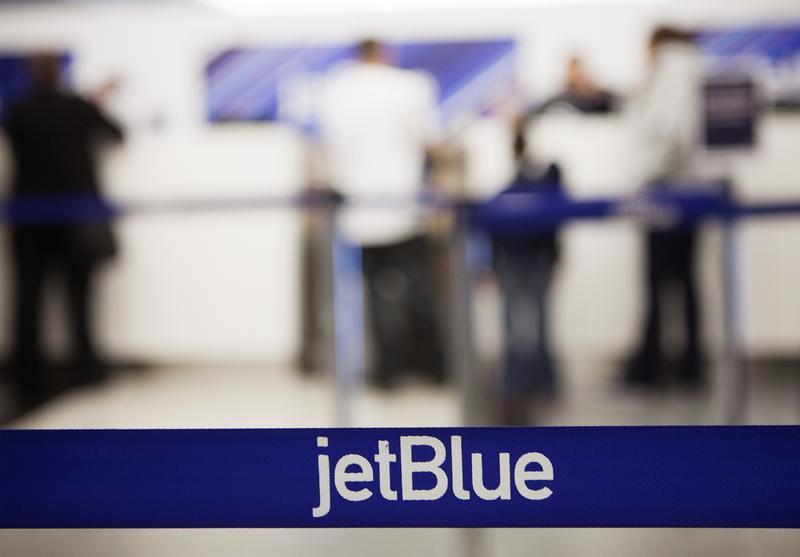Skift Take
There needs to be a middle ground between a growing company like Alaska and a mega merger deal like American's that allows for a company to post solid results and stable growth like JetBlue has done.
JetBlue Airways Corp caught the airline industry’s attention just over a decade ago with low fares and a customer-centric culture. Now, it is under pressure to show it can compete as larger rivals raise their game and smaller carriers tout their low-price advantage.
No longer an upstart but not big enough to match the scale of Delta, United or the soon-to-be merged American Airlines-US Airways, JetBlue is in the middle. It is looking to draw more business passengers that disdain its bigger brethren and keep leisure travelers who love the free TV that low-cost rivals don’t offer.
JetBlue’s success in exploiting this middle space has implications for investors as well as fare-conscious flyers.
The company has posted profits since 2009, but so have other carriers. As investments in expansion have limited its return on capital in recent years, JetBlue has to be careful that any growth it takes on will be profitable. Having key operations in expensive cities such as New York and Boston, JetBlue is also challenged to keep down costs.
It’s not that JetBlue is doing badly; airlines as a whole have recovered from the 2008-09 downturn and JetBlue has benefited from that. It’s just that these days, some of its competitors are considered more compelling performers–and investments.
JetBlue is “making progress and moving in the right direction, but the industry is moving in the right direction at least at an equal pace,” said David Fintzen, an airline analyst with Barclays. “The bar is rising and to be perceived as at the front of the industry is much tougher than it’s ever been.”
Little excitement
The New York airline has a goal to raise returns on invested capital by one percentage point a year. Last year, that stood at just shy of 5 percent, compared with 10 percent at Atlanta-based Delta and 7 percent at Dallas-based Southwest.
As stock picks among big carriers, Fintzen said he prefers Delta, which has made innovative moves such as buying a refinery to boost profits, and Southwest, which is moving out of weaker markets. He said Spirit Airlines and Allegiant are good options among low-cost airlines.
William Swelbar, research engineer with MIT’s International Center for Air Transportation, said JetBlue’s challenge was to find profitable opportunities in a saturated U.S. market–a tough task for most carriers.
“The problem with a very low ROI is that it doesn’t leave a lot of money to invest in the product,” Swelbar said.
JetBlue is not generating the excitement that has been around other airline stocks that have merged or restructured. Its stock has rallied 26 percent since the end of 2009. But Delta, for example, has risen 43 percent since then, United Continental has more than doubled and Alaska Air Group shares have more than tripled.
With the proposed merger of American parent AMR Corp and US Airways Group set to close in the third quarter, the four biggest U.S. air carriers, including Southwest Airlines , will control about 80 percent of domestic travel.
By contrast, JetBlue has just 5 percent U.S. market share. Despite a solid U.S. East Coast network that extends to the Caribbean and Latin America, it offers no service to major cities such as Atlanta, Minneapolis and Detroit.
JetBlue has dominant market share at New York’s John F. Kennedy International and Boston Logan airports. It also has operations in Los Angeles, Fort Lauderdale and Orlando in Florida, and San Juan, Puerto Rico.
Free Wi-Fi
JetBlue plans to increase flights from these markets while trying to attract more business travelers, who currently make up 20 percent to 30 percent of its passengers, it told investors on One new amenity to lure them: free Wi-Fi coming this year, a notable perk for those used to paying $20 to surf on other airlines. Next year, it plans to offer premium seating on certain cross-country flights.
The company said the lack of such features has hurt revenue on transcontinental U.S. flights.
“We think the majority of customers who are flying (cross-country) today in a competitive or first- or business-class product are paying far too much for their fares,” Robin Hayes, JetBlue chief commercial officer, said in an interview. “We’re going to have a price that wows customers,” he added.
Fintzen, the Barclays analyst, noted that the premium seating product was a year away in coming. The impact of that move is “a ways off in the distance,” he said. “That’s the most tangible revenue initiative.”
Swelbar also questioned JetBlue’s plans to expand in Florida. JetBlue said last week it has about 50 daily flights in the Fort Lauderdale market currently, and that it sees the opportunity to raise that to possibly 100 flights a day.
At the Fort Lauderdale-Hollywood International Airport, JetBlue has an 18 percent passenger share, according to January 2013 data. Major rivals there are Southwest-AirTran, which have a 19 percent share, and Spirit, with 17 percent passenger share.
“Florida has more than plentiful service today from all sectors of the industry,” Swelbar said. “My question is how much more (growth) is there?”
JetBlue defends its moves, saying it serves high-value, populated areas that offer growth opportunities.
“There are a lot of places we’re not, but at the end of the day people make a decision on airline brands based on where they live and where they want to go,” Hayes, the chief commercial officer, said. “Because of our size and our brand, we are very relevant.”
Editing by Alwyn Scott, Patricia Kranz and Andrew Hay. Copyright (2013) Thomson Reuters. Click for restrictions. ![]()
The Daily Newsletter
Our daily coverage of the global travel industry. Written by editors and analysts from across Skift’s brands.
Have a confidential tip for Skift? Get in touch
Tags: jetblue airways
